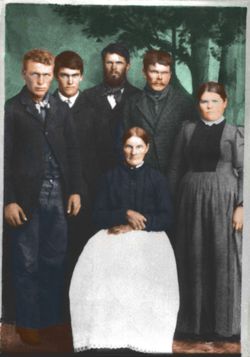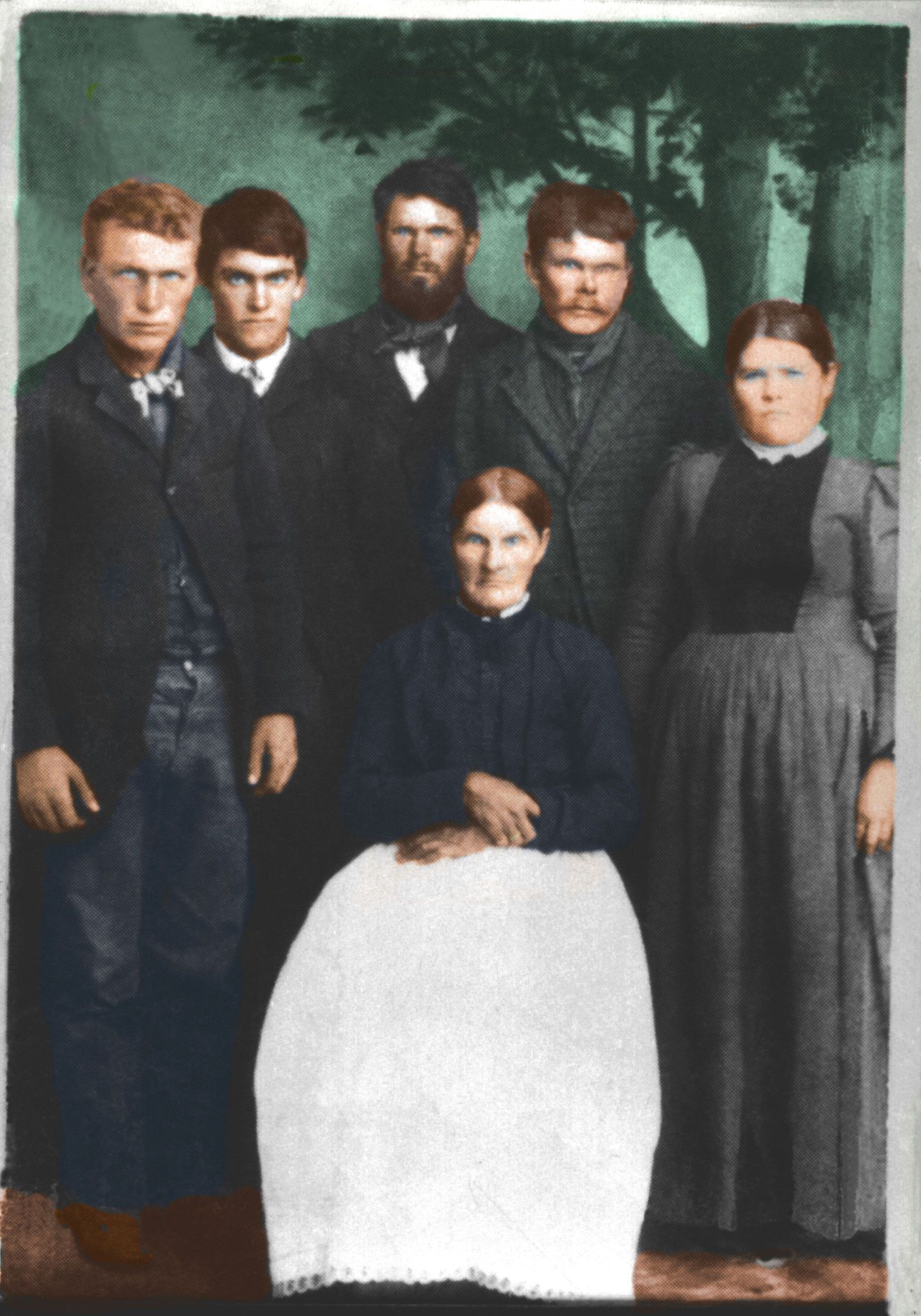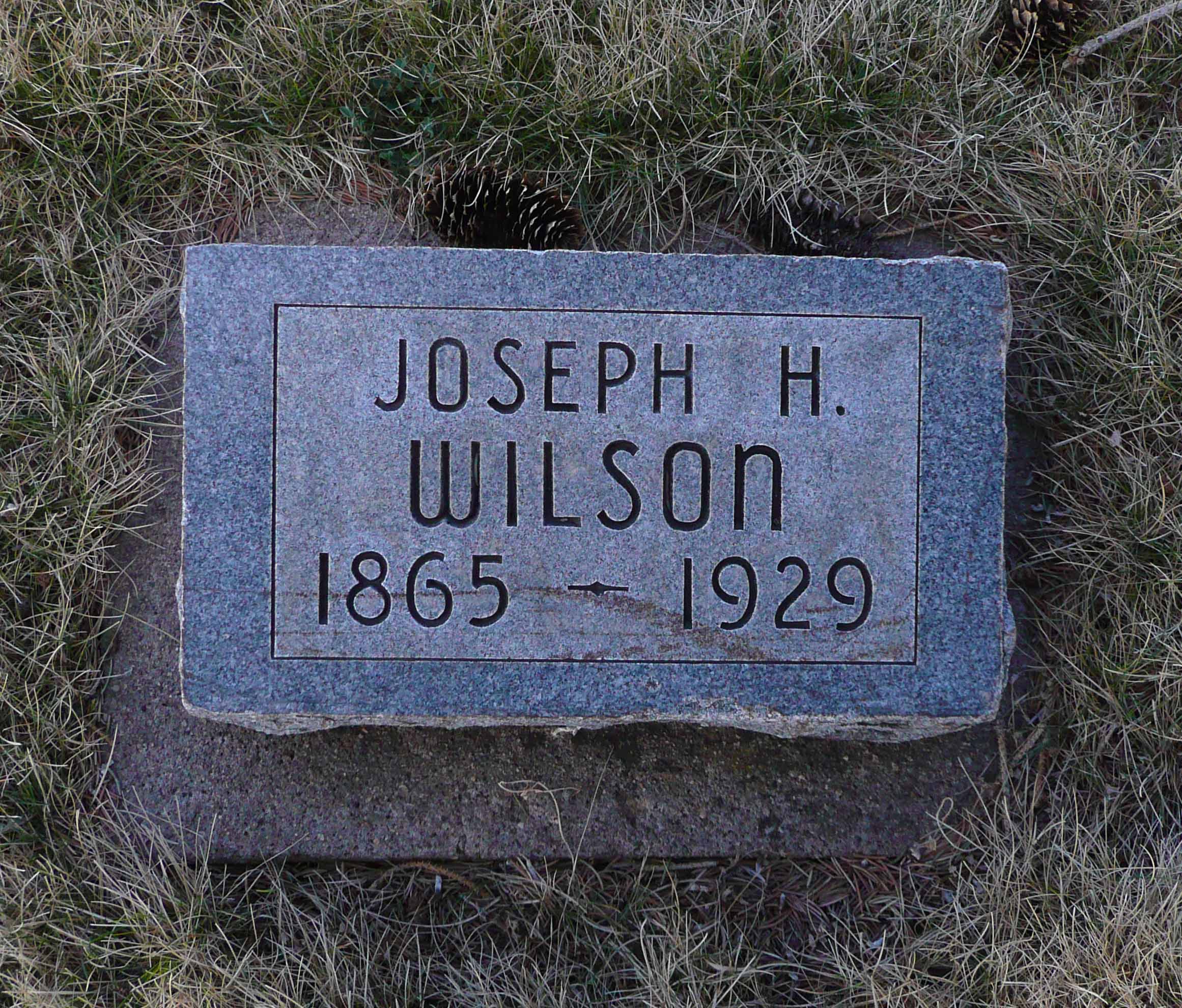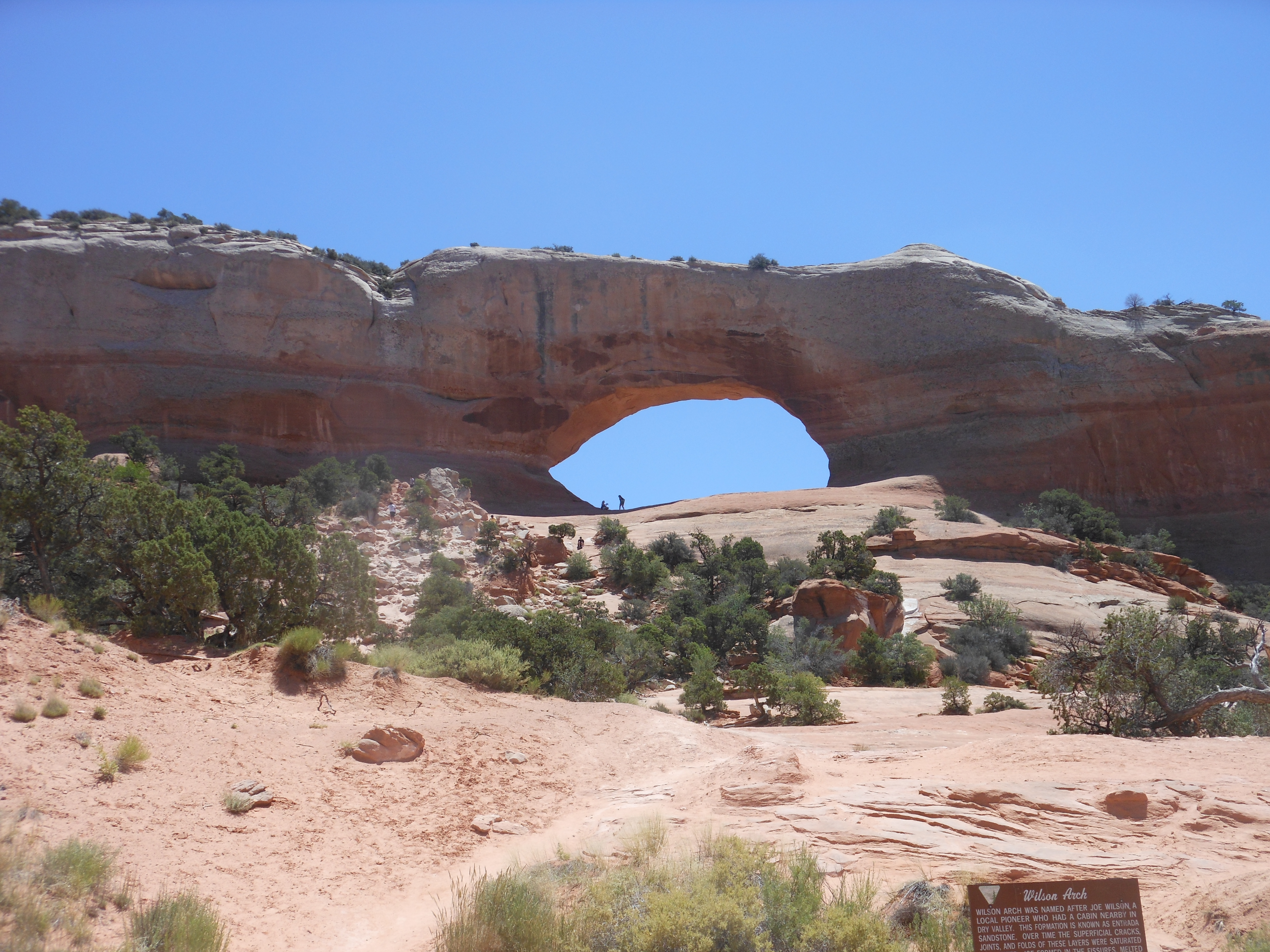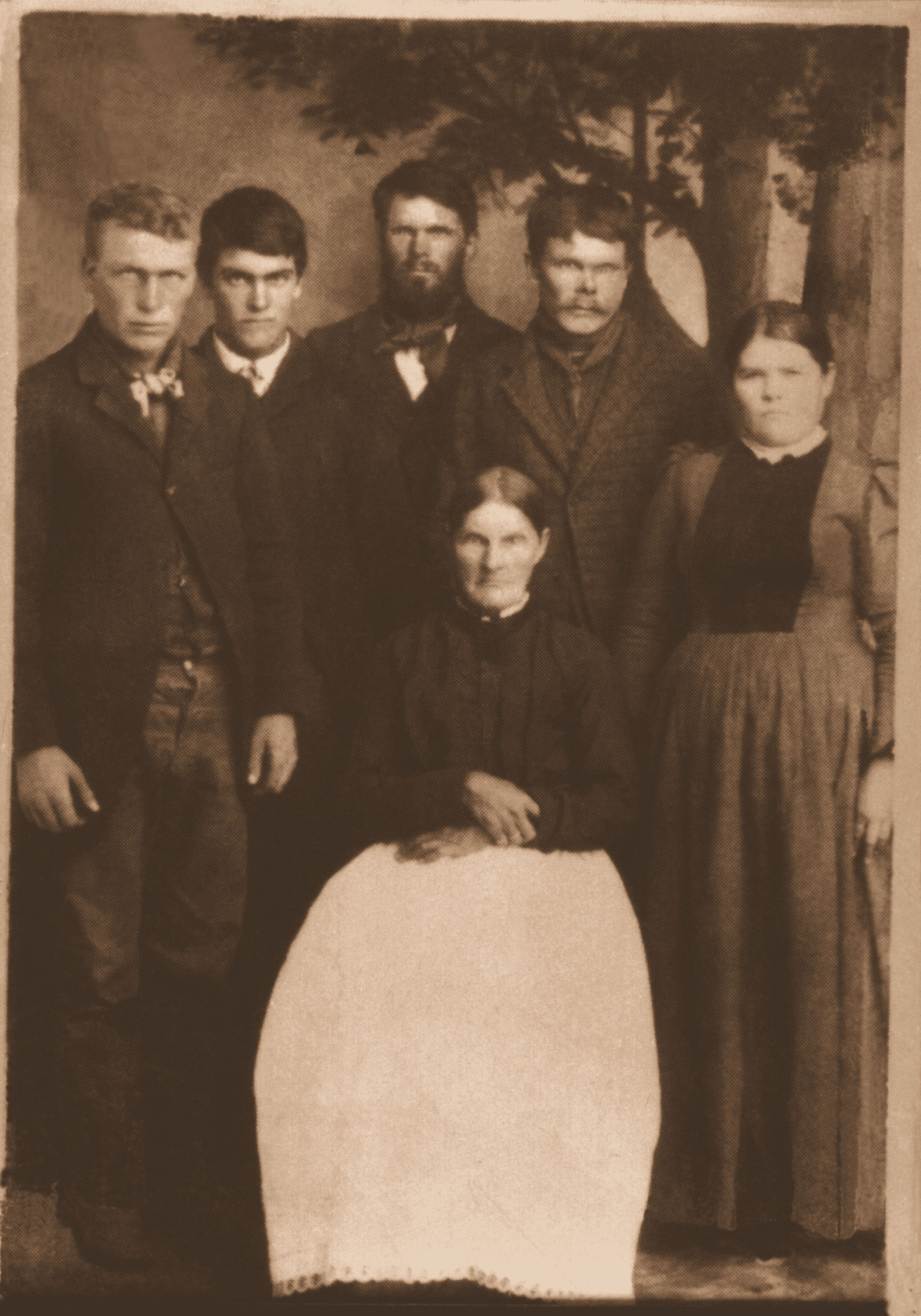Mother - Jane G. HOWARD
Joe was the 7th of 10 children born to Alfred Gideon and Jane Gertrude Howard Wilson. Alfred and his son, Alfred Ruben, arrived in the Grand Valley in 1878 and set up a home. The next spring, they returned with the rest of the family, eventually laying out what would become Moab, Utah. In essence, they pioneered Moab. At the time, there were a number of cattlemen using the valley for cattle, among them a number of "rustlers" and thieves, who apparently appropriated their cattle from herds in western Colorado.
The valley had been a favored wintering and burial ground for certain of the local Indians, dating back to the time of the Anasazi Indians.
Events in Joe's Life:
Early in the morning on August 26, 1880, Ray and Philander Maxwell recovered some horses stolen by a band of renegade Paiute Indians on the southwest end of the La Sal Mountains. Also that morning, two of Alfred's sons, Ervin and Joseph, were herding cows at the head of Pack Creek (near what was to become the M-4 Ranch).
Whether, the Indians thought they had found the Maxwells and wanted the stolen horses back or they were angry at all white men is unknown, but they decided to get even. A band of eight to ten Indians fired on the boys wounding fourteen-year old Joe in the left foot and killing his horse. Unable to walk, Joe played dead. Ervin ran south with his dog, pursued by at least one Indian. One of the Indians checked Joe to see if he was dead. The Indian rolled Joe over and said, "Buena!" probably concluding Joe was dying or already dead.
Then, the renegade Indian changed the course of Joe's life. He placed the barrel of his rifle at the right side of Joe's nose and fired, apparently trying to shoot Joe's nose off. The bullet exited below Joe's left eye. After the Indians left, Joe crawled about three miles towards Moab before he rested for the night at Pack Creek.
Meanwhile, Ervin made his way south in the direction of Coyote (near present day La Sal), a settlement he had heard of, but had never seen. He was pursued through the day and into the night. The next morning as Ervin arrived at the settlement, he was still being followed. An Indian was almost close enough to catch him. The Maxwells heard Ervin's shouts for help and exchanged shots with the Indian, scaring him off.
About this same time back at Pack Creek, two friendly Ute Indian squaws found Joe. They had heard the shots the day before and came to see what had happened. They put Joe on one of the Wilson's work horses and took him down from the mountain, arriving at the Boren Ranch (later the George White Ranch) after dark. The Indians feared they might be blamed for the attack, so they placed young Joe a little way out from the house and made a lot of noise to attract attention to him. From there, he was taken to Moab.
His mother gathered prickly pear cactus, roasted them, and scraped out the insides. She mixed that with tallow and soft pine gum, making a salve for his bullet wounds. He recovered, but walked with a limp for the rest of his life. He also lost his left eye and the bridge of his nose. His disfigured face affected his life and he spent most of his later life as a hermit on his ranch 23 miles south of Moab.
His ranch in Dry Valley included the arch named after him, "Wilson's Window" or "Wilson Arch" as it was later named by the State of Utah. Whenever he came to town he usually had a treat for the children who all knew him as "Uncle Joe." One day, he was found by a passing cowboy, seriously ill in his cabin. He was taken to Monticello where he died January 18, 1929 at the age of 64.
Mother - Jane G. HOWARD
Joe was the 7th of 10 children born to Alfred Gideon and Jane Gertrude Howard Wilson. Alfred and his son, Alfred Ruben, arrived in the Grand Valley in 1878 and set up a home. The next spring, they returned with the rest of the family, eventually laying out what would become Moab, Utah. In essence, they pioneered Moab. At the time, there were a number of cattlemen using the valley for cattle, among them a number of "rustlers" and thieves, who apparently appropriated their cattle from herds in western Colorado.
The valley had been a favored wintering and burial ground for certain of the local Indians, dating back to the time of the Anasazi Indians.
Events in Joe's Life:
Early in the morning on August 26, 1880, Ray and Philander Maxwell recovered some horses stolen by a band of renegade Paiute Indians on the southwest end of the La Sal Mountains. Also that morning, two of Alfred's sons, Ervin and Joseph, were herding cows at the head of Pack Creek (near what was to become the M-4 Ranch).
Whether, the Indians thought they had found the Maxwells and wanted the stolen horses back or they were angry at all white men is unknown, but they decided to get even. A band of eight to ten Indians fired on the boys wounding fourteen-year old Joe in the left foot and killing his horse. Unable to walk, Joe played dead. Ervin ran south with his dog, pursued by at least one Indian. One of the Indians checked Joe to see if he was dead. The Indian rolled Joe over and said, "Buena!" probably concluding Joe was dying or already dead.
Then, the renegade Indian changed the course of Joe's life. He placed the barrel of his rifle at the right side of Joe's nose and fired, apparently trying to shoot Joe's nose off. The bullet exited below Joe's left eye. After the Indians left, Joe crawled about three miles towards Moab before he rested for the night at Pack Creek.
Meanwhile, Ervin made his way south in the direction of Coyote (near present day La Sal), a settlement he had heard of, but had never seen. He was pursued through the day and into the night. The next morning as Ervin arrived at the settlement, he was still being followed. An Indian was almost close enough to catch him. The Maxwells heard Ervin's shouts for help and exchanged shots with the Indian, scaring him off.
About this same time back at Pack Creek, two friendly Ute Indian squaws found Joe. They had heard the shots the day before and came to see what had happened. They put Joe on one of the Wilson's work horses and took him down from the mountain, arriving at the Boren Ranch (later the George White Ranch) after dark. The Indians feared they might be blamed for the attack, so they placed young Joe a little way out from the house and made a lot of noise to attract attention to him. From there, he was taken to Moab.
His mother gathered prickly pear cactus, roasted them, and scraped out the insides. She mixed that with tallow and soft pine gum, making a salve for his bullet wounds. He recovered, but walked with a limp for the rest of his life. He also lost his left eye and the bridge of his nose. His disfigured face affected his life and he spent most of his later life as a hermit on his ranch 23 miles south of Moab.
His ranch in Dry Valley included the arch named after him, "Wilson's Window" or "Wilson Arch" as it was later named by the State of Utah. Whenever he came to town he usually had a treat for the children who all knew him as "Uncle Joe." One day, he was found by a passing cowboy, seriously ill in his cabin. He was taken to Monticello where he died January 18, 1929 at the age of 64.
Family Members
-
![]()
Nicholas Elijah "Nugget" Wilson
1852–1939
-
![]()
Isadore Edward Wilson
1854–1881
-
George Washington Wilson
1856–1856
-
![]()
Ervin Riley Wilson
1858–1944
-
![]()
Alfred Reuben Wilson
1860–1881
-
![]()
Harriet Elizabeth Wilson
1862–1862
-
![]()
Hyrum Smith Wilson
1867–1949
-
![]()
Nancy Almira Wilson Allen
1868–1925
-
John Andrew Wilson
1872–1872
-
![]()
William Street "Billy" Wilson
1873–1949
Sponsored by Ancestry
Advertisement
Explore more
Sponsored by Ancestry
Advertisement
